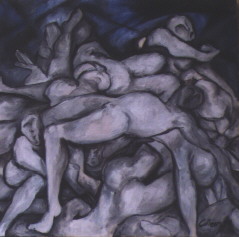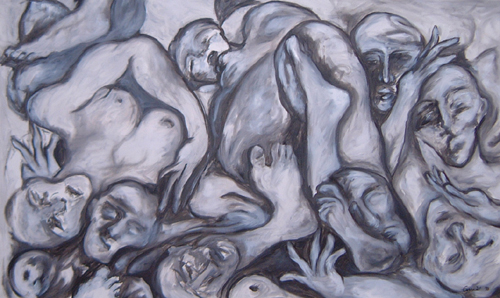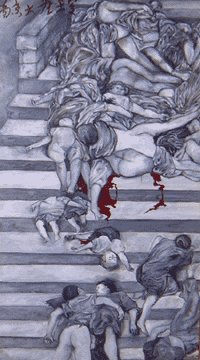Oil Paintings Gallery
 |
| The bombing of Guernica (130x200 cms) 1998 |
|
|
During World War II concentration camps were established
by the Nazi regime beginning with Dachau
in 1933, to imprison "enemies of the state." They served as prisons, forced labor camps, or extermination centers, particularly the death factories of Belzec, Chelmno, Sobibor, and Treblinka, as well as in the killing sections in Auschwitz and Majdanek (also called Lublin). Prisoners included the political opposition, dissenting clergy, undesirable ethnic groups, such as Jews and Gypsies, homosexuals, and numerous others classified simply as "antisocials" or "useless mouths." |
 Auschwitz - Heap 30x40 cms 1999 This picture is dedicated to all those people who were deported to concentration camps and who were forced to work and live in inhuman conditions. |
Auschwitz was more than a camp; in fact it was a vast complex consisting of more than 40 satellite
camps: it was a prison camp, a labor camp, an industrial center and a death camp.
The complex included the I.G. Farben Buna rubber plant, the Monowitz camp where Primo Levi was held,
the main Auschwitz camp (Auschwitz I) and the Birkenau (Auschwitz II) extermination camp,
where the majority of mass murders by poison gas took place.
|
"Living conditions" is a poor way to describe the way prisoners were forced to live in concentration camps.
The German policy was "death by work".
Stripped of their individuality, prisoners were subject to unbearable conditions that eventually led to their death.
Hunger and starvation rations, sadism, housing facilities, inadequate clothing, medical neglect, disease,
beatings, freezing, all played a major role in the organic deterioration that prisoners had to experience.
This led to the so-called "Muzulman" state, extreme physical exhaustion that ended in death.
Many inmates found that the day of liberation, the day that loomed so large in hopes and dreams, brought a curious emptiness of its own. As Henry Wermeuth, an Auschwitz survivor, described liberation day, "I was lying wrapped in my blanket in the Block. Someone else was looking out the window, and I heard him say in Yiddish, 'An American soldier.' I didn't get up. I didn't move. I lay there. The feeling cannot be described. You would have to make up a new word. 'I've done it. I've made it.' But then I thought: who has survived? I, alone. My father had just died. My sister and my mother were gone. I covered my head and wept. That was the moment of my liberation." Miguel Montesinos describes the liberation of Dachau: "All they wanted to do was get out and go home. And a lot of them did get out... The gates were wide open then, and a lot of them were confused. They didn't know what to do. Some of them couldn't walk and they were looking for direction, but there was no direction we could give them at all." |
 Death Heap 60x100 cms 1998 Stripped of the last scraps of their dignity, prisoners are dying. Their camp has been liberated, they are free. More dead than alive, these prisoners don't know where to go or what to do. Horrified and disgusted by the brutal conditions, the liberators found it difficult to understand all those people who pushed, screamed, clawed for food, smelled bad. It was just like walking in a cemetary except for the fact that people were still alive. Life was stolen, and we allowed this to happen. |
 Death Heap 60x100 cms 1998 Masses of twisted and entangled bodies stripped of their dignity were thrown into a piles left to rot. Even those who were buried were given the minimal respect. The malnutrition, the total lack of hygiene and medical care, and the brutality of the SS guards were the main causes of the death of thousands of prisoners. |
|
Tragedies in countries like Cambodia, Yugoslavia and Rwanda perhaps prove that the will to genocide is stronger than the sobering lessons of history. The exponential growth of communications media, particularly the Internet, ensure that the world will never again be blind to mass murder and genocide. The world's response to future incidents of mass murder and genocide still remains difficult to predict. People can easily adjust to a tragedy that does not involve them directly or the people they love. Although we can be greatly moved by events, they are immediate eruptions to horrible situations. It doesn't take long to forget, perhaps the very same evening. May the suffering of all genocide victims impact the hearts and minds of people, making them aware of the consequences of hatred, indifference and apathy which continues to manifest itself today. |
|
All reproductions of these original works of art are ©1990-2002 material of Colleen Corradi and may not be reproduced in any form without the written permission of the artist.
